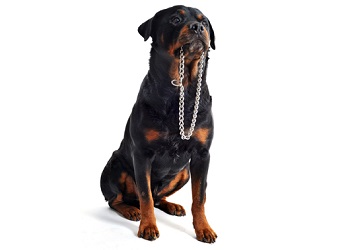 Rottweilers originated in Germany in the early 1800s. They were known as the Butcher’s Dog of Rottweil, after the small German town where they were used as a respected cattle and guard dog. They also pulled a cart around town doing meat deliveries for the butcher!
Rottweilers originated in Germany in the early 1800s. They were known as the Butcher’s Dog of Rottweil, after the small German town where they were used as a respected cattle and guard dog. They also pulled a cart around town doing meat deliveries for the butcher!
In time, the Rottweiler’s role changed to that of a police dog, serving during World War I. Today, the breed is a popular working dog in Germany and is still used in police, security and customs work throughout the world. It is also a popular companion dog well-suited to being a member of the family, not to mention competitive obedience.
Rottweilers are a powerful, protective and intelligent breed that is an ideal companion for the family
Personality
Rottweilers are very loyal and affectionate to their owners. Their powerful and muscular physique along with their self-assured and fearless temperament makes socialization and early training essential.
They are calm, courageous and naturally protective, defending their family fiercely if needed. They are highly intelligent and proven their reliability in police, military and customs. They require a lot of leadership and socialization. Rottweilers are excellent watchdogs are guarding is a natural instinct to this breed. They are welcoming to friends and relatives of the family, but certainly not to strangers! Because of their natural guarding instinct, they need to be supervised around visitors and visiting children.
The Rottweiler is a working breed and needs firm but not aggressive obedience training from a young age. They depend on consistent leadership from a pack leader that is in charge of the dog – not the other way around.
Upkeep
Rottweilers have a smooth, thick glossy coat that is easy to groom. Brush once a week and bathe when necessary. They are an average shedder.
They can overeat easily. A good quality diet and regular exercise will help to keep your Rottweiler happy and healthy. Rottweilers thrive on exercise and need plenty of it. A daily walk or jog will do, but they love running in open spaces and playing retrieving games. Swimming or running beside a bicycle are also perfect activities. Traditionally, tail docking (amputation of the tail) was performed on Rottweiler puppies when they were newly born. However, in 2004, all forms of docking became prohibited by law in Australia for routine, prophylactic or cosmetic reasons.
Compatibility
Not everyone is suitable to own a Rottweiler, particularly if family members are not capable of ensuring the dog is at the bottom of the pecking order. Rottweilers are very intelligent and will quickly pick up on any weakness in this area.
They need an owner who is strong minded, calm, but firm to handle their massive size. Just as with other breeds of dog – supervision is imperative when they are around children. Relatively active indoors, Rottweilers can live in apartments as long as they get sufficient exercise every day. A small yard is also adequate. They will not be happy confined to a kennel or backyard for long periods of time.
Fact file
Breed classification Working
Size Large
Origin Germany
Lifespan 10-12 years
Colors Black
Cost $1200 – $1500
Common hereditary problems Orthopedic disorders, elbow and hip dysplasia, bloat, eye and mouth problems, heart problems, hypothyroidism.
